Developing effective strategic plans is what helps companies thrive in today’s competitive business environment. However, despite the time spent brainstorming, discussing, and planning strategically, around two-thirds of business executives feel that their planning processes did not yield effective strategies.
The failure of strategic planning for businesses is often attributed to the unpredictability of a competitive market. For example, new trends and big events can negatively affect your strategic plan—but only if you do not anticipate and navigate such changes.
Along those lines, it is important to recognize that strategic planning is not a one-time event. It is comprised of ongoing processes and effective planning strategies that must be capable of evolving in response to emerging challenges and opportunities.
In this article, we will review the elements of strategic planning and using visual tools to document strategic plans. We will also discuss the benefits of strategic planning for any business, as well as how MindManager® makes it easy to implement strategic planning for startups, entrepreneurs, project managers, and more.
What are the elements used in strategic planning?
Strategic planning frameworks first became popular in the 1950s. Since then, hundreds of planning models have been developed, such as OSGM (Objectives, Goals, Strategies, Measures), Balanced Scorecard, and the 7S Model.
No two strategic planning frameworks are identical. However, they all share the following 6 elements:
- Vision statement. A vision statement describes what your business will look like in the future. By making everyone aware of your long-term goals, they can conduct their work with consideration for the broader organizational strategy.
- Mission statement. A mission statement defines the ‘how’ and ‘why’ of what your organization does. It often identifies elements such as your key offerings, target audiences, and what differentiates your company from the competition. Mission statements also describe how you intend to achieve your vision.
- Goals and objectives. A goal is a broad statement of what your organization plans to achieve. Objectives define the actions, methods, or paths used to achieve the goal. You need both goals and objectives to support your overall vision statement.
- SWOT analysis. A SWOT (Strengths, Weaknesses, Opportunities, Threats) analysis is used to assess your position in the market. It helps business leaders determine potential challenges and successful strategies for achieving organizational goals.
- Action plan. An action plan contains the tactics for reaching the short- and long-term goals and objectives of the strategic plan. Action plans include important information for each goal or objective, including timeframes, responsible parties, and required resources.
- Key performance indicators (KPIs). KPIs are measurable, objective metrics that enable business leaders to track performance in relation to company goals. They are directly related to your strategic objectives and guide the decision-making process.
Understanding the elements of strategic planning benefits organizations and their various teams and departments. A strategic plan brings a sense of purpose and significance to day-to-day work activities, increasing the likelihood of achieving your organization’s goals and objectives.
Using visual tools for strategic planning
Developing a strategic plan can be as simple as creating a word document, but this approach might not make the most impact. Studies suggest that approximately 65% of people are visual learners, which is why strategic planning elements are best captured and communicated with visual tools.
Visual learning occurs when a person sees information in order to understand it. Diagrams, flowcharts, timelines, and maps are all examples of visual productivity tools that help individuals process and retain information.
Companies use visual tools to create customized maps and charts to guide strategic planning efforts. Visualizing your strategic plan helps you brainstorm and organize ideas, identify resources and timelines, assess challenges and opportunities, and more.
Let’s take a closer look at some of the mapping and visualization tools available in MindManager.
SWOT Analysis
Analyzing your strengths, weaknesses, opportunities, and threats helps you develop strategic goals. You can use a SWOT analysis template to assess these four segments and how they relate to one another. With everything displayed in a clear visual format, it’s easy to expand ideas and identify opportunities for growth or change.
By visualizing strengths, weaknesses, opportunities, and threats in a SWOT matrix, you can identify connections that drive business performance. For example, do your strengths support identified opportunities? Would eliminating weaknesses limit potential threats?
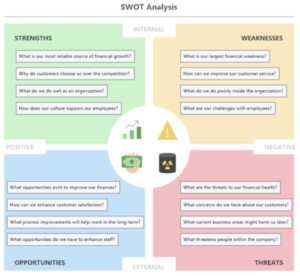
A SWOT analysis helps you analyze data and prioritize actions to achieve your objectives and goals.
While the simplicity of a SWOT matrix offers plenty of value as a stand-alone tool, there is more than one way to visually represent SWOT analyses. Another option is a SWOT analysis business case, which breaks down the four sections into primary topics in a flowchart. Each section is connected to additional subtopics to ensure that you address all relevant strategic planning elements.
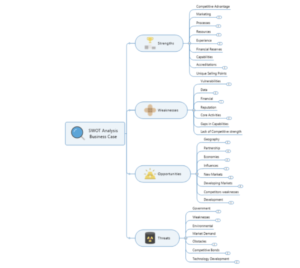
A SWOT analysis business case lists various factors that relate to your company’s strengths, weaknesses, opportunities, and threats.
DESTEP
A DESTEP analysis diagram helps business leaders, product managers, project managers, and other professionals break down the complexity of strategic planning elements. These diagrams are often used in coordination with SWOT analysis to respond to and strategize for external opportunities and threats.
DESTEP analysis charts are used to evaluate external influences that can impact your organization. Remember, strategic planning is an ongoing process that must account for unexpected changes that you cannot control.
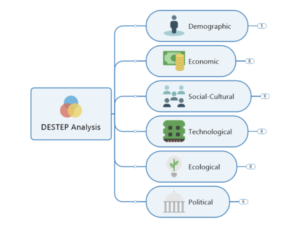
Identifying and investigating each of the DESTEP forces helps you develop more effective business forecasts.
PEST
A PEST analysis gives you a big-picture view of how political, economic, socio-cultural, and technological factors can affect your organization. It is like a DESTEP analysis but the factors included in the analysis differ.
In a PEST analysis:
- Political factors are aspects of governmental policy that could impact the economy, regulatory requirements, and more.
- Economic factors such as inflation and economic growth influence people’s willingness to spend money on various products and services.
- Social factors affect your target audience and include considerations such as culture, lifestyle, and trends.
-
Technological factors influence how businesses get things done, and what can be impacted byconsiderations such as automation and new, more advanced technical tools.
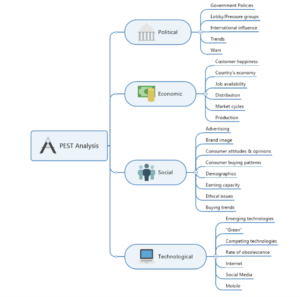 PEST analysis helps you see the big picture and identify opportunities in product and business development.
PEST analysis helps you see the big picture and identify opportunities in product and business development.
Strategy map
A strategy map helps you brainstorm, organize, and prioritize objectives as you map out your path to success. These visualization tools highlights your primary goals, the steps needed to achieve them, and their connections to other tasks and objectives.
Strategy maps are single-page diagrams, streamlining one’s understanding of how various processes come together to meet the organization’s strategic objectives. They can be used in almost all business activities, such as developing new products, planning marketing campaigns, or standardizing processes throughout your company.
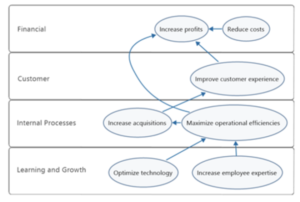
Using shapes and arrows, strategy maps visualize the cause-and-effect relationships among strategic objectives.
Strategic planning
One of the best ways to visualize the elements of strategic planning is to use a customizable strategic planning template. In MindManager, these templates contain five primary topics: preparation, current state, future vision, strategy, and plan management. Each primary topic further expands into subtopics, ensuring that nothing is forgotten as the strategic plan is built out.
A strategic planning diagram represents the culmination of the efforts taken to streamline and improve business processes. Various strategic planning elements are included in the diagram, such as:
- The vision statement, which is part of the ‘Where are we going?’ topic.
- The mission statement, which is part of the ‘Where are we now?’ topic.
- The SWOT analysis and PEST/DESTEP analysis, which are parts of the ‘Where are we now?’ topic.
- The objectives and goals, which are part of the ‘How will we get there?’ topic.
- The action plan and KPIs, which are part of the ‘How will we manage the plan?’ topic.
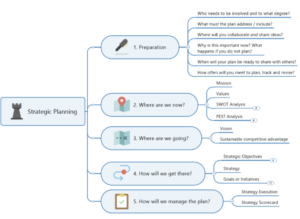
Strategic planning diagrams support the ongoing process of using available information to track progress based on strategic goals.
MindManager’s collection of visual productivity tools encompass a wide variety of ready-to-use strategic planning templates. These bring clarity and structure to strategic plans for startup businesses, established organizations, or product and project management teams alike.
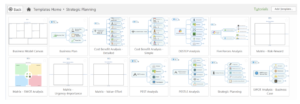
MindManager gives you a variety of customizable strategic planning templates to meet your business needs.
Available for Windows, Mac, Chromebook, and capable of integrating with Microsoft Teams, MindManager keeps teams working synchronously and asynchronously across platforms to enhance real-time collaboration.
Enhance strategic planning for products, projects, and processes. Try MindManager free for 30 days.

